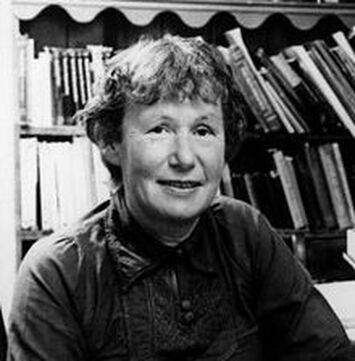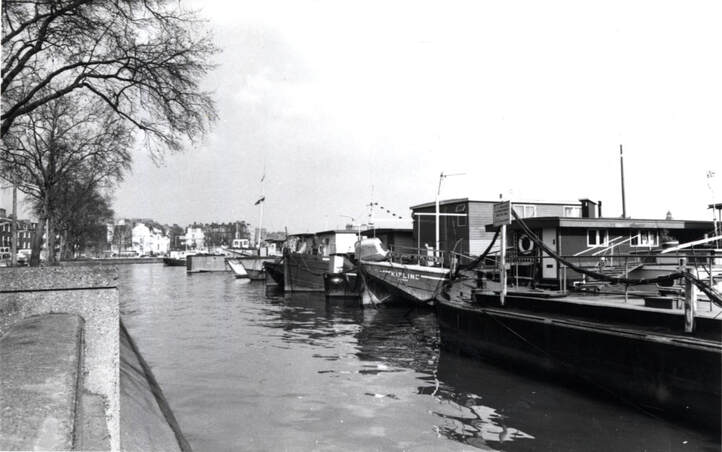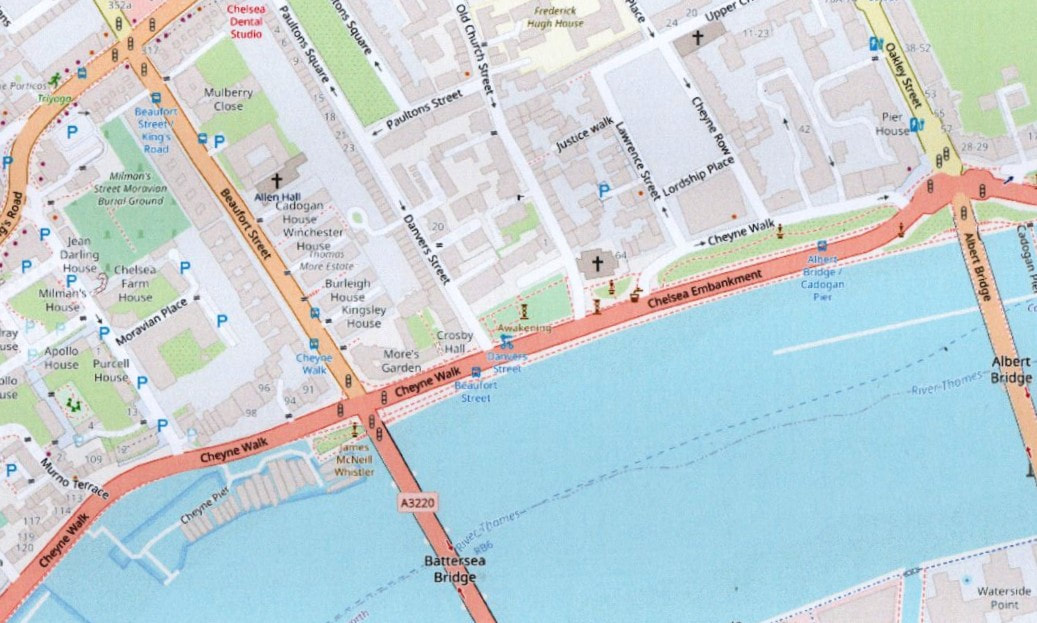John Wilson

Offshore is the novel of Chelsea Boats – the houseboats moored off the stretch of Cheyne Walk upriver from Battersea Bridge to where the road curves away from the river. The story is set in the early 1960s (dates are a little inconsistent) and is a fairly intense evocation of life on the boats. For Fitzgerald an essential characteristic of the little community of boat-dwellers is in-between-ness: they do not belong to the terra firma of Chelsea, but their boats cannot sail anywhere, and at low tide they rest on the mud. Their dwelling is determined by something in their characters: ‘They aspired towards the Chelsea shore….But a certain failure, distressing to themselves, to be like other people, caused them to sink back, with so much else that drifted or was washed up, into the mud moorings of the great tideway’.
This affectionately humorous tone is predominant throughout the novel. The author maintains an amused distance from her characters, but is clearly on their side.
The setting is not exactly like the real-life location: for example, in the book the landmark Chelsea Flour Mills has been replaced by a non-existent brewery, and nobody ever mentions the enchanting sight of Albert Bridge lit up at night.
The story concerns the inhabitants of six of the boats. The “heroine” is Nenna James, who lives on a decommissioned Thames sailing barge called “Grace” (as Fitzgerald did) with her daughters Tilda (6) and Martha (12). Nenna came from Nova Scotia to London after the war to study music. She married as a student but is now estranged from her husband, Edward, who refuses to live on the Grace. Nenna wants him to, because she loves him. When he comes into the story, quite late in the novel, he seems utterly unlovable. Nenna bought Grace with their last £2000 while Edward was working in Panama, but now finds herself powerless to change anything in her life and has given up trying to take decisions. She is the most boat-bound of the characters; although a trained musician,she now has no job, spends her days on board, and becomes almost disoriented when she has to go beyond the adjacent streets. We are given full access to Nenna’s thoughts – her persistent anxieties and feelings of guilt. She constantly finds herself in a grotesquely patriarchal court in her own mind where she is being cross-examined about – and always blamed for – the dismal state of her marriage.
Richard Blake has no difficulty taking decisions, in fact his methodical mental process is described in some detail. He lives on a converted minesweeper, not because he has to but because, having been a naval officer during the War, he just likes ships. His wife Laura doesn’t like it so much and is scheming to get them ashore. He chairs meetings of the boat-owners, at which he insists that everyone should be addressed by the name of their boat; he has named his own boat “Lord Jim”, and sees nothing funny about being so addressed. Nenna, who seems his opposite, instinctively understands him. Seeing him distressed, she says ‘“I wish I knew the exact time”’, which is a cue for Richard to show off his chronometers. ‘He was able to give her not only the time, but the state of the tide at every bridge on the river. It wasn’t very often that anyone wanted to know this.’ In the end, however, Richard is shown to have as little control over his own fate as Nenna.
One of the boats is a Dutch barge belong to Maurice, who renamed his boat “Maurice” as soon as he learnt that he would be addressed by his boat’s name. Maurice is an amiable male prostitute and Nenna’s confidant, but so easy-going that he allows a nasty criminal called Harry, whom he believes to be his friend, to store stolen goods on his boat. This plays a crucial part in the climax of the story.
The humour of the novel contains sadness. Nearly all the main characters have chronic anxieties, not least about their boats. Fitzgerald’s boat-dwellers are far from the carefree bohemians passers-by might imagine. At the end the little community is broken up, with two boats for sale, one sunk, and Maurice swept away in a storm to an undisclosed fate.
The life of the river is nearly always present, not only the tide lifting and dropping the boats, but the passing vessels. Tilda in particular knows the meaning of every flag and light carried by the ever-present tugs, and the signals they make with their hooters. The effect is maintained by using correct nautical terms, for example the tide is “making” rather than just coming in. For all the characters, the river’s movements are a constant part of their lives, whether they welcome it or even realise it or not. The boats are almost characters themselves. Most are Thames barges, and there are several rather romantic references to their former lives sailing down the river and along the east coast, both in the author’s own voice and in Tilda’s daydream.However, the Thames barges here are strikingly less watertight than the Bells’ Blackbird in The Water Gipsies.

Character and story are tightly integrated in this quite short novel: The story moves along briskly, but every episode tells us something about the characters of those involved; and while the author tells us quite a bit directly about the characters, particularly Nenna, at the end we don’t know anything about any of them that wasn’t relevant to the story. The one whose life we learn the most about is Willis, a retired marine painter who is trying to sell his unseaworthy boat Dreadnought. Willis is a part of the riverside, ‘born in Silvertown, within sound of the old boatbuilders’ yards’, a brief resume of his past brings in some of the Thames beyond Battersea and Chelsea Reaches. Tilda wants to be a marine painter like Willis, and he sometimes takes her to the Tate gallery to look at the sea and river paintings, where she coolly points out errors in the warning lights on the bridges in Whistler’s paintings. Tilda and Martha also take the story to the New King’s Road. In one episode they visit an old wrecked barge on the Battersea side at low tide and recover lustre tiles by William de Morgan from the mud.They then visit an antique shop, ‘one of many enterprises in Chelsea which survived entirely by selling antiques to each other’. It did seem just like that, and Martha’s hard bargaining with the owner, who tries to cheat the children but is no match for Martha’s detailed knowledge of the de Morgan pottery, is quite plausible. A later visit to the King’s Road, when Martha takes a visiting teenage boy from Vienna to see some boutiques, is perhaps more a satire on “Swinging London” than realistic observation: ‘in this, its heyday, the King’s Road fluttered, like a gypsy encampment, with hastily-died finery…Sellers, dressed in brilliant colours, outshone the purchasers…There were no prices, no sizes, no way to tell which stock was which…and the spirit was that of a market scene in a pantomime when the cast, encouraged by the audience, has let the business get out of hand’.
When Nenna finally makes an expedition outside the hinterland of the Boats, it seems she may have been right not to try it before. She goes to visit Edward at his address in Stoke Newington (42b Milvain Street; there is no such street), believing that he will be unable to resist her love and will come back with her to live on Grace. The journey is much more difficult than it would be now, and Stoke Newington seems obscure and remote from “real” London. Obviously no-one ever spoke of “Stokey” in the 60s. When Nenna finally reaches the house no-one answers the bell, but she is eventually let in by a man who turns up and who she learns is Gordon, a friend of Edward whom she had apparently met but has forgotten. He explains ‘My mother is taking your husband in, at considerable inconvenience, as a kind of paying guest’ because Gordon knew Edward at school. Edward is in fact in his room, and was looking out of the window the whole time. They quarrel, helped along by Gordon and his mother’s interventions. Edward’s character is displayed as mean in every sense, until finally he shouts at Nenna ‘“you’re not a woman!”’. This leads to Nenna’s night walk through North East London. Having left the house abruptly, she realises when she reaches Seven Sisters Road that she has left her purse in Edward’s room, and has no money. ‘Nenna set out to walk. A mile and a half down Green Lanes, half a mile down Nassington (sic) Green Road, one and a half miles the wrong way down Balls Pond Road, two miles down Kingsland Road, and then she was lost”. Nenna is rather comically Catholic: “Prayer should be beyond self, and so Nenna repeated a Hail Mary for everyone in the world who was lost in Kingsland Road without their bus fares’. Kingsland Road (as it must have been in the early 60s) is evoked mainly be descriptions of the shops Nenna passes. Nenna loses her shoes escaping from a creep who accosts her. Eventually a kindly taxi driver picks Nenna up and takes her back to Battersea Reach for nothing, where it seems her emotional life is going to reach a resolution. Richard is standing on the deck of Lord Jim at 3 or 4 am, and tells Nenna ‘“My wife’s left me”’. Richard invites Nenna for a romantic night-time trip in his dinghy in his characteristic way: ‘“We could go up under Wandsworth Bridge as far as the Fina Oil Depot and then switch off and drift down with the tide”’ Without any discussion they spend the night together.
But they don’t make a new life together. The next day Richard is attacked by Harry and so badly injured he needs emergency surgery to save his life. As soon as he is convalescent, Laura carries him off to the house she always wanted them to live in. Meanwhile Nenna’s decisive and wealthy sister Louise has arrived from Canada to take charge of Nenna’s life, as she considers Nenna has shown herself incapable of doing so. In Richard’s absence Nenna is unable to oppose Louise’s plan to take her and Tilda and Martha back to Halifax, where Louise has their lives planned. But the future is not entirely closed off, as there is an implication that Richard will seek Nenna out in Canada next year.
‘The night before Nenna and her two daughters were due to leave England, storm weather began to blow up on the reach’. The storm is described with telling detail, in the streets and on the river – police boats and tugs warning the boat dwellers. Nenna takes her children to land for the duration of the storm, and the last we read of them is ‘Tilda put on her anorak. She thought them all cowards’.
In a rather curious coda, Edward arrives, drunk, to give Nenna her purse and a present. He gets as far as Maurice, where he and Maurice drink whisky together. Maurice breaks free of her mooring in the storm: ‘It was in this way that Maurice, with the two of them clinging on for dear life, put out on the tide’.
John Wilson is a lifelong enthusiast for London the city and for London in literature, art and film. He came to London to study Physics at Imperial College and has lived in various parts of the city ever since.

Chelsea Boats today
The boats are still there along Cheyne Walk, and larger and more numerous (and more colourful) than they were in the 1960’s. Even then there was a more fashionable element among the boat-owners than Fitzgerald describes.
The process of gentrifying London takes place on the river as well as on land. The majority of boats today are almost floating houses built up on steel hulls. There was never a minesweeper, but there was a torpedo boat, which has long gone from Chelsea but is apparently still intact and being made seaworthy again.
Dutch barges like Maurice are still to be seen (although more thoroughly converted to homes) but leaky old boats like Dreadnought and Grace would not be allowed.
Since Fitzgerald lived there the boats are no longer restricted to flushing their toilets on a falling tide, and residents and visitors no longer need to clamber from one boat to another. But the boat owners are in protracted disputes with the owners of the moorings who are apparently seeking more expensive boats paying higher fees, and the owners of older and smaller boats fear being pushed off.
The riverside industry on both sides has gone, but mostly wasn’t mentioned in the novel anyway. Lots Road Power Station was decommissioned in 2002 and is now the centrepiece of a ‘buzzing new urban lifestyle destination’.
Kingsland Road has become something of an entertainment destination, with a quite widely-known jazz club and cinema, and many Turkish restaurants – as well as Turkish shops and a remarkable blue-tiled mosque.

References and Links
Penelope Fitzgerald, Offshore, Harper Collins 2009
Hermione Lee, Penelope Fitzgerald: a Life, Vintage 2014
https://en-gb.facebook.com/chelseaboats/ The Facebook page of Chelsea Reach Boatowners Association. Many photographs of the boats today, and occasional older photos from the 60s and 70s
https://rbkclocalstudies.wordpress.com/2015/01/15/fiction-in-kensington-and-chelsea-3-offshore/ From The Library Time Machine, more photographs of Chelsea Boats in the 1970s selected to illustrate passages from Offshore
All rights to the text remain with the author.
